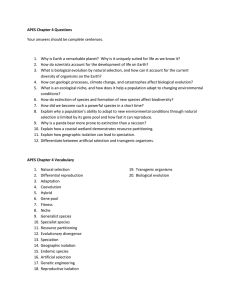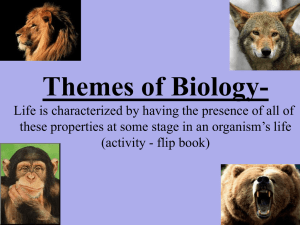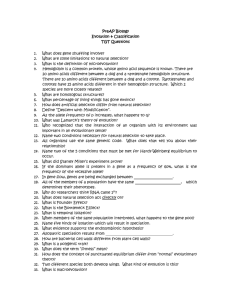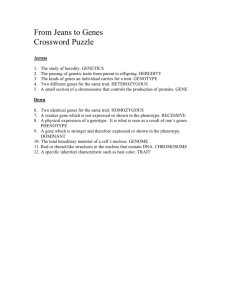Evolution & Gene Frequencies Worksheet: Natural Selection & Speciation
advertisement
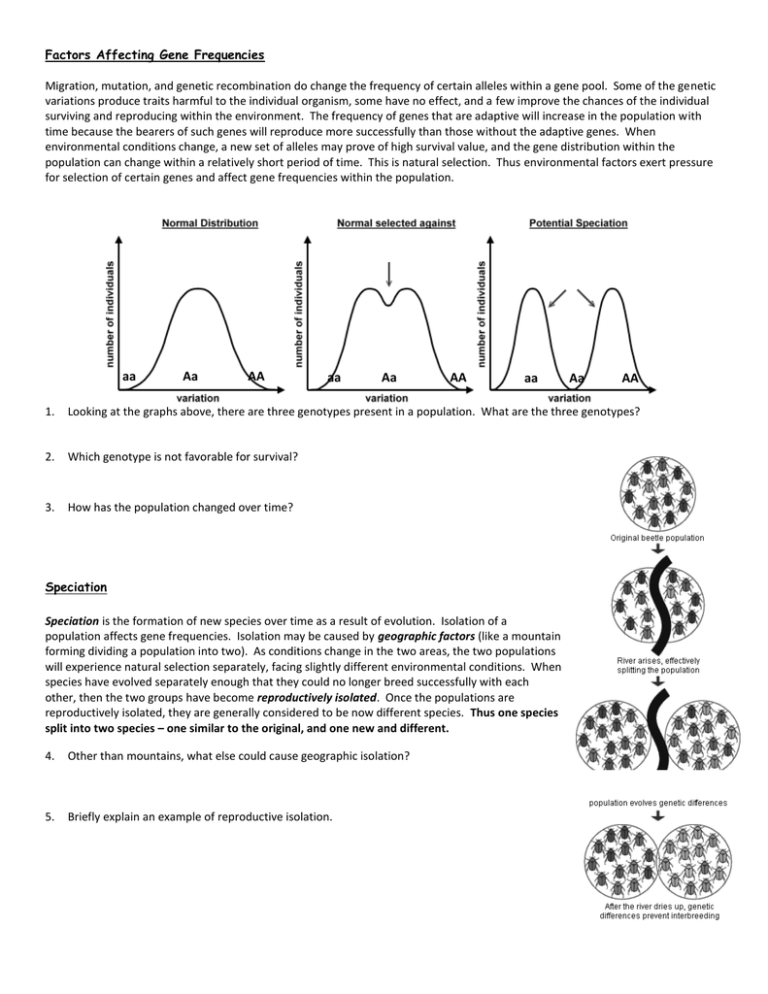
Factors Affecting Gene Frequencies Migration, mutation, and genetic recombination do change the frequency of certain alleles within a gene pool. Some of the genetic variations produce traits harmful to the individual organism, some have no effect, and a few improve the chances of the individual surviving and reproducing within the environment. The frequency of genes that are adaptive will increase in the population with time because the bearers of such genes will reproduce more successfully than those without the adaptive genes. When environmental conditions change, a new set of alleles may prove of high survival value, and the gene distribution within the population can change within a relatively short period of time. This is natural selection. Thus environmental factors exert pressure for selection of certain genes and affect gene frequencies within the population. aa Aa AA aa Aa AA aa Aa AA 1. Looking at the graphs above, there are three genotypes present in a population. What are the three genotypes? 2. Which genotype is not favorable for survival? 3. How has the population changed over time? Speciation Speciation is the formation of new species over time as a result of evolution. Isolation of a population affects gene frequencies. Isolation may be caused by geographic factors (like a mountain forming dividing a population into two). As conditions change in the two areas, the two populations will experience natural selection separately, facing slightly different environmental conditions. When species have evolved separately enough that they could no longer breed successfully with each other, then the two groups have become reproductively isolated. Once the populations are reproductively isolated, they are generally considered to be now different species. Thus one species split into two species – one similar to the original, and one new and different. 4. Other than mountains, what else could cause geographic isolation? 5. Briefly explain an example of reproductive isolation. What evidence supports evolution? 6. Match the statement with the type of evidence. ____ ____ ____ ____ ____ ____ A. Fossil B. Anatomical C. Physiological D. Embryological E. Biochemical F. Universal genetic code A record of ancient life forms in rock. The hemoglobin in blood of humans and chimpanzees is remarkably similar. A seal’s flipper and the similar bat’s wing are homologous structures. All organisms have DNA built from the same nucleotides (A,T,G,C). Early stages of development in many species with backbones is very similar. Vestigial structures remain in some organisms, and no longer serve any apparent function. Mechanisms of Evolution Check out this really good explanation… http://glencoe.mcgrawhill.com/sites/9834092339/student_view0/chapter20/animation_-_mechanisms_of_evolution.html Related questions: 7. Do individuals evolve, or do populations evolve? 8. Complete the chart Mechanism Genetic Drift Gene Flow Mutations Nonrandom Mating Definition Example Peppered Moths Looking at the photo at the right… 9. Which moths will survive better (not get eaten by predatory birds) and reproduce? 10. Over time, what color moths do you expect to only find living in a region with light colored trees? With dark colored trees? Lamarck was Darwin’s rival, and came up with his own theory of natural selection called “use and disuse.” Lamarck’s theory is not widely supported by scientific evidence. Examine the scene below, comparing the sides. 11. What is the main problem with Lamarck’s theory? HINT: Remember only traits that can be inherited will affect the survival of future generations. Practice Questions: Use the circle graphs below to answer the question. 1. The graphs illustrate change in a lizard population over time. Which process most likely led to the change in the lizard population? A. natural selection acting on a harmful trait B. natural selection acting on a beneficial trait C. natural selection acting on a dominant trait D. natural selection acting on a recessive trait 2. In North America, the eastern spotted skunk mates in late winter, and the western spotted skunk mates in late summer. Even though their geographic ranges overlap, the species do not mate with each other. What most likely prevents these two species from interbreeding? A. habitat isolation B. gametic isolation C. geographic isolation D. reproductive isolation 3. A mutation occurs in the genes that code for coat color in deer. Which change will most likely result from this mutation? A. a change in the selection pressures acting on coat color B. a change in the coat-color genes of deer predator species C. an increase in coat-color diversity in the population D. an increase in the number of genes for coat color in the population 4. Two continental plates collide and begin to build up a mountain range. Gradually, a species of lizards becomes separated by the mountain range. The members on one side can no longer interact with members on the other side. Due to their separation, the two populations of lizards a. will evolve in exactly the same manner and remain as one species. b. will likely become extinct within one year. c. will likely evolve into separate species over millions of years. d. will begin hunting one another for food. 5. According to the theory of natural selection, which of the following organisms is most likely to survive in the given environments? a. a rabbit with short, brown fur in a cold, snowy, arctic environment b. a large, leafy plant with shallow roots in a hot and dry desert biome c. a bird with a short beak in an area where insects live deep within the ground d. a lizard that exhibits the same coloration as its surrounding plant life 6. What information do fossils provide about the history of organisms on Earth? a. Organisms have stayed exactly the same since the Earth was formed. b. Organisms on Earth have not evolved or changed during the last 200 years. c. Fossils do not provide any information about the history of organisms on Earth. d. Organisms on Earth have evolved and changed significantly over time. Use the illustrations below to answer the question. 7. The skeletons of mammalian forelimbs represent variations of a structure that was present in their common ancestor. What has most likely caused the variation in forelimbs? A. changes in muscle structure B. changes in the genetic codes C. trait formation due to behaviors D. development of vestigial structures

